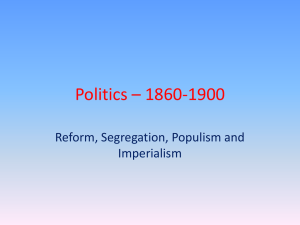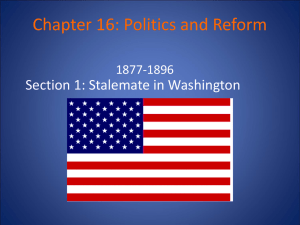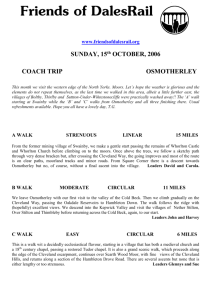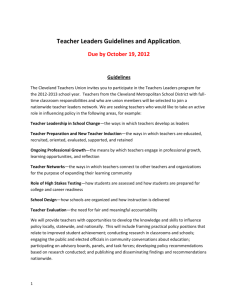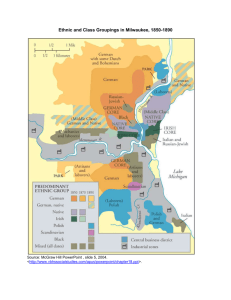6.9 Farm Revolt
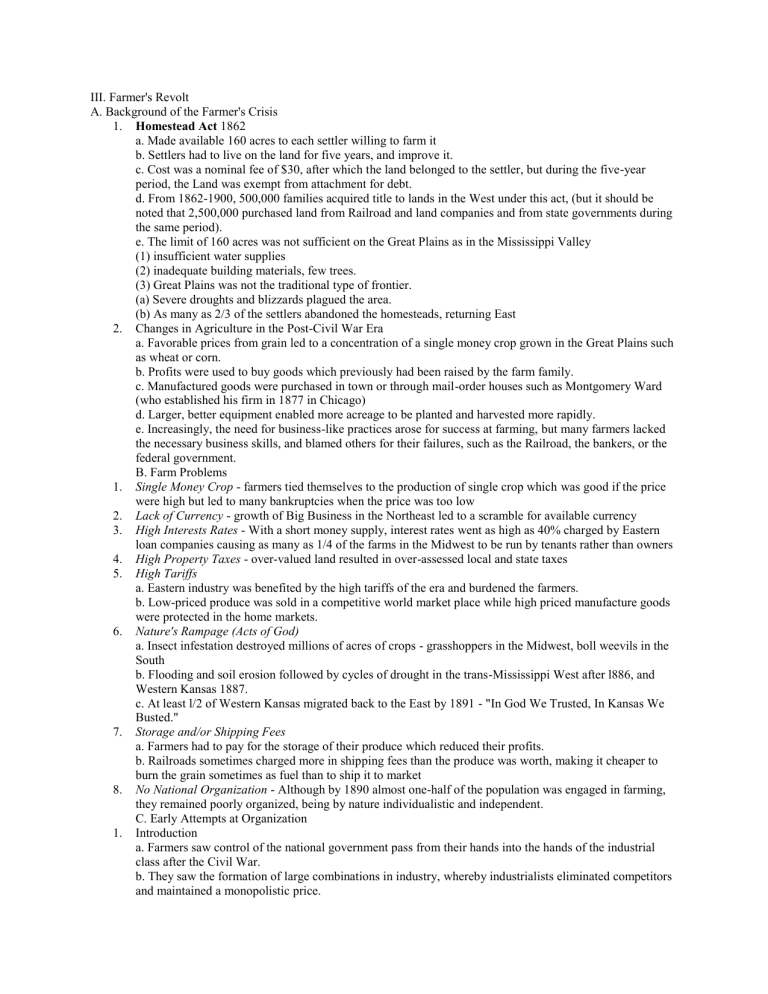
III. Farmer's Revolt
A. Background of the Farmer's Crisis
1.
Homestead Act 1862 a. Made available 160 acres to each settler willing to farm it b. Settlers had to live on the land for five years, and improve it. c. Cost was a nominal fee of $30, after which the land belonged to the settler, but during the five-year period, the Land was exempt from attachment for debt. d. From 1862-1900, 500,000 families acquired title to lands in the West under this act, (but it should be noted that 2,500,000 purchased land from Railroad and land companies and from state governments during the same period). e. The limit of 160 acres was not sufficient on the Great Plains as in the Mississippi Valley
(1) insufficient water supplies
(2) inadequate building materials, few trees.
(3) Great Plains was not the traditional type of frontier.
(a) Severe droughts and blizzards plagued the area.
(b) As many as 2/3 of the settlers abandoned the homesteads, returning East
2.
Changes in Agriculture in the Post-Civil War Era a. Favorable prices from grain led to a concentration of a single money crop grown in the Great Plains such as wheat or corn. b. Profits were used to buy goods which previously had been raised by the farm family. c. Manufactured goods were purchased in town or through mail-order houses such as Montgomery Ward
(who established his firm in 1877 in Chicago) d. Larger, better equipment enabled more acreage to be planted and harvested more rapidly. e. Increasingly, the need for business-like practices arose for success at farming, but many farmers lacked the necessary business skills, and blamed others for their failures, such as the Railroad, the bankers, or the federal government.
B. Farm Problems
1.
Single Money Crop - farmers tied themselves to the production of single crop which was good if the price were high but led to many bankruptcies when the price was too low
2.
Lack of Currency - growth of Big Business in the Northeast led to a scramble for available currency
3.
High Interests Rates - With a short money supply, interest rates went as high as 40% charged by Eastern loan companies causing as many as 1/4 of the farms in the Midwest to be run by tenants rather than owners
4.
High Property Taxes - over-valued land resulted in over-assessed local and state taxes
5.
High Tariffs a. Eastern industry was benefited by the high tariffs of the era and burdened the farmers. b. Low-priced produce was sold in a competitive world market place while high priced manufacture goods were protected in the home markets.
6.
Nature's Rampage (Acts of God) a. Insect infestation destroyed millions of acres of crops - grasshoppers in the Midwest, boll weevils in the
South b. Flooding and soil erosion followed by cycles of drought in the trans-Mississippi West after l886, and
Western Kansas 1887. c. At least l/2 of Western Kansas migrated back to the East by 1891 - "In God We Trusted, In Kansas We
Busted."
7.
Storage and/or Shipping Fees a. Farmers had to pay for the storage of their produce which reduced their profits. b. Railroads sometimes charged more in shipping fees than the produce was worth, making it cheaper to burn the grain sometimes as fuel than to ship it to market
8.
No National Organization - Although by 1890 almost one-half of the population was engaged in farming, they remained poorly organized, being by nature individualistic and independent.
C. Early Attempts at Organization
1.
Introduction a. Farmers saw control of the national government pass from their hands into the hands of the industrial class after the Civil War. b. They saw the formation of large combinations in industry, whereby industrialists eliminated competitors and maintained a monopolistic price.
c. They felt economically oppressed by railroads who discriminated against smaller farmer. d. They felt themselves economically injured by the national banking system which favored the industrialists and prevented the freeflow of credit to smaller agricultural communities
2.
National Grange of the Patrons of Husbandry (the Grange) a. Granger Movement was the first attempt by farmers to strike back at the industrial and railroad giants oppressing them. b. Oliver Hudson Kelley founded a secret society in 1867 in Fredonia NY which was at first non-political
- its original goal was to stimulate farm families with social, educational and fraternal activities such as picnics, lectures and music presentations. c. Its structure was similar to Masons -- they used passwords and secret handshakes and contained a fourlevel hierarchy (Laborer to Husbandman, men; Maid to Matron, women). d. Women, usually subjected to loneliness, especially liked Granger activities. e. Growth
(1) By 1871, it was introduced into SC and quickly spread through the South
(2) By 1874, it had 858,000 members and peaked at 1 1/2 million from the mid-West and South f. Its economic platform illustrated their contempt for industrial and banking interests
(1) It advised farmers to dispense with middlemen and commission agents.\
(2) It expressed violent opposition to monopolies and trusts.
(3) It demanded regulation of the railroads by state and national governments in the interests of the producers.
(4) It advocated agricultural and industrial education. g. Goals:
(1) They tried to improve the farmer's plight by establishing farmer's co-ops
(2) An attempt to manufacture their own harvesting machinery failed because of mismanagement.
(3) Succeeded in raising the Department of Agriculture to the Cabinet Level
(4) Obtained rural delivery and parcel post services h. They entered the state political arena, having some success in the Upper Mississippi Valley area (Illinois,
Wisconsin, Iowa, Minnesota) i. Some success at regulating the railroads and grain elevators was achieved at the state level, but the successes were restricted by later Supreme Court decisions. j. Granger Decline -- membership eroded by 85% by 1880
(1) The laxness of organization permitted many persons who were not interested in the farmer and his problems to join.
(2) The huge, unwieldy mass within the organization led to dissension in the ranks.
(3) The connection of the Grange with many political movements led to its decline.
(4) The Grange failed to secure permanent and effective railroad regulation
(5) The main cause was the failure of the Granger cooperative endeavors, which went to pieces, and left a burden of discredit and indebtedness.
3.
Greenback Labor Party - 1878 a. Organized in Toledo with 800 delegates from 28 states, the Greenback and Labor Reform Parties combined farmer and labor issues
(1) Stood for more greenbacks in circulation and the free coinage of silver
(2) Advocated fewer working hours, and restrictions on Chinese immigrants to US b. In 1878, they polled l,060,000 votes and sent 14 members to Congress c. In 1880, they endorsed such issues as Women's suffrage, a graduated income tax, and federal regulation of interstate commerce
(1) James Weaver, their presidential candidate in l880, received 3% of the vote
(2) Benjamin Butler in 1884 did not do as well as Greenbackers had in 1880. d. Because it was primarily a third party effort, it failed to make much headway in the South, except in
Alabama, where Greenbackers demanded adequate educational facilities, denounced the convict-lease system, and cried for an equalization of the tax burden.
4.
Alliance Movement a. Numerous farmer's alliances emerged in many states, hoping to unite black and white farmer's facing the same economic issues. b. The first, Knights of Reliance , was established by a cattleman's association in Lampassas County Texas in 1877 and quickly spread throughout the cotton states.
c. By 1890, the various farmer's alliances claimed membership of 1 million d. Stressed the use of co-ops to buy fertilizer and other supplies collectively gaining a cheaper price than individually. e. All alliances agreed that farm prices were too low, transportation costs were too high, and that something was wrong with the financial system of America. f. Unfortunately, these alliances adopted different policies throughout the country, and therefore remained at best only regional in effectiveness. g. Continued sectionalism hampered their unification
(1) Northern Alliances voted Republican, favored the tariff, focused on regulation of railroads and federal land policies, resisted synthetic foods like margarine and generally came to favor the formation of a new
Party
(a) National Farmer's Alliance formed by Milton George
(b) Won Kansas legislature, Nebraska legislation and was the balance of power in Minnesota and South
Dakota
(2) Southern Alliances voted Democrat, opposed the tariff, focused on financial reforms, were against land syndicates and crop futures speculation, and favored the one-party system of the Solid South - Democrat
(a) National Farmer's Alliance and Industrial Union was a merger of farmer's alliances in the South and
Southwest i) It included everyone "not obnoxious to the Constitution," which excluded railroad officials, bankers, cotton buyers, real estate brokers, shopkeepers ("anyone who bought and sold for gain") ii) Unfortunately it also excluded Blacks farmers
(b) Won control of 8 Southern legislatures, 44 Congressional or Senate seats
(c) A Segregated Colored Farmer's Association claimed one million members in 1888 h. An attempted merger in 1889 failed because of the differences:
(1) Southern Alliance had three times as many members
(2) Blacks were members of the Northern Alliance.
(3) South's practice of secret rituals was unacceptable to the Northern Alliance.
D. Populist Movement
1.
Early Leadership a. Ignatius Donnelly (1831-1901) - Minnesota, elected three times to Congress, and populist candidate in l900. b. Mary Elizabeth Lease - popular speaker urged farmers to "raise less corn and more Hell" c. Tom Watson (1856-1922) - Georgia Congressman, Senator and Governor and later Populist vicepresidential candidate in 1896, presidential candidate in 1904 d. "Sockless Jerry" Simpson - Kansas Congressman e. William A. Peffer - Kansas Senator f. James Kyle - South Dakota
2.
Early attempts at National Unity - Beginning in 1890 a. Agrarian interests in the West and South + labor + Grangers + Greenbacks met in St. Louis in Dec l889. b. People's Party formed in Kansas June 1890 c. Southern Alliance + Farmers' Mutual Benefit Association + Colored Farmers' Alliance met in Ocala
Florida to draw up a list of grievances
(1) Labor representatives called for the creation of a new party
(2) Southern representatives resisted its formation, fearing a rise in Black power.
3.
Those who favored a national effort were frustrated by the failure of agrarian efforts to liberalize the
Democratic Party or get Republicans to listen to their demands and were encouraged by successes at the state level when unified, and therefore met to unite in 1892.
4.
Issues raised a. Regulation and government ownership of railroads, telegraph and telephones b. Free Unlimited Coinage of Silver -- their major issue c. The issuance by the federal government of legal tender notes and the abolition of national banks as banks of currency issue d. A graduated income tax e. A "sub-treasury plan" (Southern innovation) to permit farmers to receive loans against their unperishable produce when prices were low by storing the goods in government warehouses until prices went up and then selling the goods and repaying the loans.
f. A parcel post to combat the express companies g. An 8-hour day for wage earners h. Immigration restrictions of undesirables i. Popular election of US Senators j. Electoral innovations such as initiative, referendum and the secret ballot. k. Restricting land ownership to US citizens l. At first calling for full civil rights for all citizens (Black members who could not vote were no good to the party), the People's Party met resistance to this in the South where it was feared that Blacks would gain political power.
5.
Organization of the Populist Party a. A national meeting in Cincinnati 19 May 189l with 1400 delegates from 32 states planned independent action from the major parties b. February 1892 - People's Party of the USA ("Populists") was formed in St. Louis with 800 delegates c. Their first national convention met in July 1892
(1) James Weaver was nominated for president and polled over one million votes, carrying Colorado,
Kansas. Idaho and Nevada with 22 electoral votes.
(2) In 1896, Democrats captured their chief issue (free coinage of silver), leading them to endorse the
Democrat, William Jennings Bryan
(3) To keep a separate identity, Tom Watson (GA) was nominated vice-president d. Why Populism Failed as a Viable Third Party Effort
(1) Southern farmers did not abandon the Democratic Party
(2) Nationally, Democrats embraced the key Populist issue, free coinage of silver, which spelled their doom as a serious political party effort
(3) Farmers entered into a period of relative prosperity from 1897 - 1920, making money more plentiful and lessening the demands for extreme financial reforms. e. Achievements of the Independent Farmers Movement
(1) Although they failed as a viable third party effort, many of their proposals were adopted over the next two decades, including
(a) Initiative and referendum adopted in many states
(b) Direct election of Senators - 17th amendment l913
(c) Secret ballot in many states adopted
(d) Graduated income tax passed under Cleveland allowed a tax on incomes over $4000, although the
Supreme Court struck it down in Pollock vs Farmer's Loan & Trust Co , the 16th amendment 1913 made an income tax constitutional
(e) Eight-hour work day a reality today
(2) A much greater emphasis was placed on popular education and social and economic reform, esp. in the
South, which led to increased regulation of railroads and banks by state govern-ments, the expansion of state departments of agriculture, the utilization of the party primary instead of the state convention as the means of nominating candidates, the replacement of the old party ballot with the secret ballot, and the shift to a commission form of city government.
(3) Overall, the Populists greatly liberalized the US political system but failed to reform the financial situation or achieve government ownership of the railroads, telephone or telegraphs f. Nationwide, Cleveland Democrats of the conservative east were replaced by more progressive Bryan
Democrats from the mid-west. g. Unfortunately in the South, while conservative Bourbon Democrats were ousted from the party's control, a new type of leader emerged, demagogues, who stirred the people to democratic revolt and used class agitation and race hatred to rise and stay in power, offering little substantive progressive legislation
IV. Politics of the Gilded Age
A. Administrations of Garfield (20th) and Arthur (21st)
1.
Struggle over the Spoils of Office a. James G. Blaine's appointment as Secretary of State was a victory for the Half-Breed Republican faction. b. The struggle over control of the customs collectors's job at the port of NY was won when Garfield nominated a Conkling opponent, William H. Robertson, who was eventually affirmed
(1) Conkling retired from politics and the Stalwart faction declined.
(2) This was as much a victory for Presidential power as it was for "Half-Breeds."
2.
Garfield the man a. The son of Ohio homesteaders and last of the log cabin presidents was president of Hiram College at age
26. b. Allegedly, he could write Latin with one hand and Greek with the other simultaneously. c. He was a Major General in Civil War who resigned in 1863 to become a Republican congressman for 17 years until his election to the presidency in 1880. d. He was the first left-handed person to be elected President.
3.
Assassination of Garfield 2 July 1881 a. Office seekers flooded the White House, where Garfield found it hard to say no. b. At a train station in Washington DC, en route to Williams College in Massachusetts on 2 July 1881,
Garfield was shot by a mentally unstable, disappointed office seeker, Charles J. Guiteau , stating as he shot him: "I am a stalwart and Arthur will be president." c. Garfield lingered in agony for eighty days with a 44 caliber bullet in his back before dying on 19 Sept
1881 in Elberon NJ, 2 months shy of his 50th birthday. d. Guiteau was tried, convicted and executed (30 June 1882).
4.
Arthur's Presidency a. Although second in command to the stalwart Roscoe Conklin who expected him to appoint numerous
Conklinites to political offices, Arthur stated: "Conklin made me vice-president but God made me
President" and appointed equal numbers from among supporters of Blaine and Conklin. b. A 9-man Tariff Commission recommended substantial tariff reductions, but a Republican-dominated
Congress did not act on this recommendation. c. Pendleton Act 1883 - Public reaction to Garfield's assassination + Democratic victories in the Bi-
Elections of 1882 forced a Republican congress into civil service reform.
(1) A Civil Service Commission was created to administer examinations to determine a merit basis for appointees to Federal offices.
(2) It forbade the levying of political campaign assessments on Federal office holders
(3) It called for apportioning appointments among the states according to population
(4) It established a limited civil service list that the President expanded as he desired d. Other actions under President Arthur
(1) Corrupt Republicans were prosecuted.
(2) Pork barrel legislation was vetoed
(3) Secretary of the Navy Whitney built a steel Navy
(4) Commodore Stephen Bleecker opened the US Naval War College in 1884 in Newport RI to provide naval officers with postgraduate training in advanced naval science and warfare, international law and history.
(5) Chinese Exclusion Act 1882
(6) Bureau of Labor was created as part of the Dept of the Interior in 1884
(7) The Senate failed to ratify a treaty to build a canal across Nicaragua
B. Election of 1884 - Arthur, who angered too many Republicans particularly from his own faction, was not nominated for President in his own right (but he died in 1886 of Bright's Disease, a liver ailment.)
1.
Candidates a. Republicans in Chicago
(1) On the fourth ballot, James Gillespie Blaine (ME), Garfield's Secretary of State, who served in both
House and Senate, was nominated
(2) Gen. John A. Logon (IL) was nominated as Vice-President
(3) Republicans were badly split over the issue of civil service reform.
(a) Stalwarts or Conklingites staunchly supported the party.
(b) Half-breeds , led by Blaine, strongly supported civil service reform, but remained supporters of the
Republican party.
(c) " Mugwumps " (Algonquin for "Big Chief"), led by George William Curtis and Sen. Carl Schurz (MO), bolted the party and as Liberal Republicans, agreed to support the Democrat, if sufficiently liberal. b. Democrats in Chicago nominated the 47-year-old reform-minded, bachelor Governor Stephen Grover
Cleveland (NY) for President and Thomas A. Hendricks (IL) for Vice-President. c. Greenback Labor Party also endorsed Butler for president.
2.
Campaign -- the dirtiest in US politics. a. Blaine in the published Mulligan letters was linked to the Credit Mobilier scandal
(1) He was investigated by the House of Representatives in 1876 and charged with illegally using his influence.
(2) In one letter, Blaine requested from a friend, a reply which disavowed that he had any part in the railroad scandal.
(3) The missive ended with "Burn this letter!" but the letter survived.
(4) Democrats shouted the slogan Burn Burn Burn this letter!
b. Cleveland, while mayor of Buffalo NY, was linked to the illegitimate son of a widow.
(1) Cleveland did not deny his relationship with the woman.
(2) Several men had known her company but Cleveland, the only bachelor, provided child support.
(3) Republicans countered with the slogan Ma Ma Where's My Pa?
c. Because neither Cleveland nor Blaine served in the Civil War, the "Bloody Shirt" issue was dead, but the campaign focused on a choice between immorality (Ma! Ma! Where's My Pa?) versus dishonesty (Burn
Burn Burn this letter!). d. A blunder by a Blaine supporter in NY, the Rev. Samuel D. Burchard , angered Irish Catholics and cost
Blaine NY's electoral votes and therefore the election.
(1) Burchard referred to Democrats as the party of Rum, Romanism and Rebellion , a slap against Irish immigrants who voted Democrat.
(2) The angry Irish turned out in greater numbers than they probably would have and gave Cleveland a
1,149 vote margin in NY of 1,125,000 votes cast.
3.
Results: a. Cleveland 4,911,017 - 219 electoral votes to Blaine 4,848,334 - 182 electoral votes b. Butler 175,370; St. John 150,369
C. Cleveland's administration as 22d President - 49 years old
1.
He supported the principle of laissez faire (French for "allow them to do"), the doctrine which meant that the government should not interfere with business
2.
Presidential Succession Act was passed in 1886 which provided for succession to proceed through the
Cabinet in the order of creation of those offices
3.
Dawes Severalty Act (seen previously)
4.
Hatch Act funded agricultural experimental stations to be located in most states to study farming techniques, crop diseases, crop uses and abuses in order to reverse the trend of top-soil erosion, the result of poor land management and crude farming methods
5.
Interstate Commerce Act (seen later)
6.
Fought to reduce a Treasury surplus by reducing the tariff
7.
February 1889 - Department of Agriculture was elevated to a Cabinet level position as farming became big business.
8.
Vice-president Hendricks died on November 1885 and was not replaced
D. Election of 1888
1.
Background a. Cleveland had angered several important groups of voters during his first term, including Texas farmers, by vetoing a bill to provide seeds for drought stricken areas, reasoning that "the government should not support the people " b. He furthered angered cattle ranchers by nullifying their illegal leases of Indian grasslands (which partially led to the Dawes Severalty Act) c. Cleveland resented the press' interest into his private life especially after he married 23-year-old Francis
Folsom , the youngest first lady ever. d. Cleveland tried to stop the free coinage of silver under the Bland Allison Act by calling for a reduction of the tariff to reduce the treasury surplus. e. Most importantly, Cleveland angered the powerful Union veterans' lobby -- Grand Army of the
Republic (GAR).
(1) He appointed two Cabinet positions to former confederates, and suggested that captured Confederate battle flags be returned to their respective states.
(2) Arrears Pension Act 1879 allowed more veterans to have pensions
(a) He investigated each individual claim, vetoing any appearance of fraud.
(b) Pensions rose from $56 million in 1885 to $80 million by 1888.
(c) Although vetoing more bills than any previous president, 413 (2/3) bills, earning him the wrath of the
GAR, he also signed more than any president
(3) Dependent Pension Bill introduced by Sen Henry W. Blair (NH) allowed all honorably discharged veterans with at least 90-days service, who were not able to earn their support or who were dependent on manual labor, to receive a pension.
(a) Congress passed it in Jan 1887.
(b) 11 February - Cleveland vetoed it, claiming that it would make the pension list a refuge for fraud, rather than an "honor roll "
2.
Major Candidates a. Democrats in St. Louis renominated Cleveland for a second term, although less enthusiastically and
Allen G. Thurmond for vice-President. b. Republicans in Chicago
(1) Facing thirteen candidates, Republicans nominated on the eighth ballot Senator Benjamin Harrison
(1833-1901) (IN), grandson of ninth President, William Henry Harrison, although defeated for reelection as
Senator in 1887 (Blaine and McKinley were on all eight ballots)
(2) Levi P. Morton (NY) was nominated as vice-president
3.
Campaign a. The major issue was the tariff. b. Cleveland's affair in Buffalo resurfaced and the press also was interested in his marriage to Francis
Folsom, but the campaign was not nearly as dirty as in 1884. c. Murchison Letter , supposedly written by British-born Charles Murchison to Sir Lionel Sackville-West,
British ambassador to the US, was printed in Republican papers
(1) The letter asked who he should vote for in the interests of Great Britain
(2) Publication of the letter's response, which indicated a vote for Cleveland was best for Britain, angered
Irish voters, giving NY to Harrison by 14,000 votes.
(3) The letter was actually written by George Osgood , California Republican.
4.
Results a. GAR support for Harrison plus the outcome in NY gave Harrison 233 electoral votes to 168 for
Cleveland, although Cleveland had a plurality of 100,000 popular votes (5,540,050 to 5,444,337). b. Republicans gained control of both Houses of Congress (strengthened in the Senate by the addition of six states, all voting Republican).
E. Harrison's Administration As 23d President
1.
Harrison the man a. His great-grandfather signed the Declaration of Independence, his grandfather was President and his father was an Indiana Congressman. b. An Indiana Senator and a Civil War General, he had aided Garfield's campaign. c. His wife Carrie oversaw a major renovation of the White House, installing the first electric lights, and having the first White House Christmas Tree.
2.
Domestic Issues a. 51st Congress -- " billion dollar Congress " -- first congress to spend a billion dollars annually in peacetime. b. Dependent Pensions Act 1890 was designed to deal with a Treasury surplus
(1) James Tanner appointed Commissioner of Pensions.
(2) Pension rolls of Civil War veterans swelled from 676,000 to 970,000 with costs swelling from $81 to
$135 million annually. c. Sherman Anti-Trust Act 1890 - 2 July
(1) Following the lead of KS and other states, Congress passed a law aimed at monopolistic trusts by declaring illegal trusts as in restraint of trade or commerce
(2) It was greatly weakened by ambiguous language, that was applied to unions.
(3) NJ permitted holding companies to be legally chartered in the state, which allowed trusts to circumvent this anti-trust legislation. d. Sherman Silver Purchase Act 1890 - 14 July
(1) Western interests in Congress, in return for support for the McKinley tariff, secured Northeastern support for this bill
(2) It promoted the free coinage of silver by requiring the government to purchase 4.5 million ounces of silver per month at current market prices and to mint coins e. McKinley Tariff 1890
(1) The highest peacetime tariff with an average of 48.4%
(2) Its author, Rep. William McKinley of Ohio, was defeated for reelection.
(3) In response, the Bi-Elections of 1890 returned the House to the Democrats. f. Redistribution of Indian lands
(1) April 1889 - Two million acres in Oklahoma was opened to white settlers
(2) 1890- 11 million acres in SD was opened to non-Indian settlement.
F. Election of 1892
1.
Candidates a. Republicans in Minneapolis renominated Benjamin Harrison for President and Whitelaw Reid (NY) was nominated for Vice-President b. Democrats in Chicago on the first ballot nominated Grover Cleveland for President for a third time and added Adalai E. Stevenson (IL) for Vice-President c. Populists in Omaha nominated James B. Weaver and James G. Field (VA)
2.
Campaign a. Although Populists were active in the Midwest, the campaign was relatively quiet, clean b. Harrison's pro-tariff stance hurt his image in the light of the Homestead strike of 1892.
3.
Results a. Cleveland - 5,554,414 (277 electoral) votes; Harrison - 5,190,801 (145 electoral) votes. b. Populists carried 6 western, Midwestern states 1,027,329 popular (22 electoral) votes
G. Cleveland's Second Administration (24th president)
1.
Panic of 1893 continuously plagued his second administration. a. In a special session of Congress, Cleveland pushed to repeal the Sherman Silver Purchase Act, an issue that badly split the Democratic Party b. Congress met from 7 August until 30 Oct debating its repeal before finally repealing it 239-108 on 28
August and the Senate repealing it on 30 October by 48-37.
2.
To stop the flow of gold out of the US treasury, Cleveland arranged a $65 million loan from Wall Street financier J.P. Morgan to be made in gold in l895.
3.
Cleveland's use of federal troops ended the Pullman strike 1894, which damaged his image
4.
April 1894 - Ohio businessman Jacob S. Coxey led a march, known as Coxey's Army, on Washington of about 500 unemployed workers who demanded relief, wanting a federal works program, the move ended with the arrest of the leaders.
5.
Wilson-Gorman Tariff (1894) only slightly reduced it from an average of 48.4% to 41.3%. a. It replaced any lost revenue with a 2% tax on incomes over $4000 b. The tax was declared unconstitutional in Pollock vs Farmer's Loan and Trust 1895
6.
Cleveland withdrew a Treaty of Annexation between the US and Hawaii a. He had sent J.H. Blount to investigate the background of the treaty b. Blount, from the South, remembered the presence of federal troops during Recon-struction, against
Southern wishes and therefore did not believe in forcing persons into a particular position against their wishes. c. He discovered the unorthodox events which led to the treaty and suggested that because native
Hawaiians did not support annexation, it should not occur, and Cleveland agreed
H. Election of 1896
1.
Bi-Elections of 1894 - Because the Panic of 1893 had made Cleveland very unpopular, the Republicans again controlled the House, although Populists enjoyed a 42% increase in votes.
2.
Candidates a. Republicans in St Louis
(1) Gov William McKinley (OH) was nominated for President, although many regarded him as a puppet of business kingpin Marcus Alonzo Hanna , his campaign manager
(2) Garret A. Hobart (NJ) was nominated for Vice-President
(3) Republicans endorsed the gold standard, although promising to work for the silver standard internationally, supported a protective tariff and favored annexing the Hawaiian Islands b. Democrats in Chicago
(1) Although Cleveland offered himself for a third term, he was bypassed in favor of 36-year-old William
Jennings Bryan , who electrified the convention with his Cross of Gold speech, blasting the gold standard in favor of unlimited coinage of silver.
(2) Arthur Sewall (ME) was nominated for Vice-President c. Some Republicans, led by Henry M. Teller, met as the National Silver Republicans and endorsed the
Democratic candidates d. Some Democrats, under the banner of National Democrats, favored the gold standard and nominated 79year-old John M. Palmer (IL) and Simon B. Buckner (KY) e. Because the Populists had their chief issue, the free coinage of silver, stolen by Bryan and the
Democrats, they endorsed Bryan for President to unite the anti-McKinley vote, but tried to maintain a separate identity by nominating Tom Watson (GA) for Vice-President, a move that killed the Populist Party as a viable third party effort
3.
Campaign a. Bryan campaigned vigorously -- 14 weeks, 29 states, 13,000 miles and 600 speeches. b. McKinley never left his front-porch at home in Canton Ohio. c. Republicans, with a war chest of $16 million to the Democrats $1 million, successfully painted Bryan as an anarchist and dangerous revolutionary d. This election pitted debtor against creditor, West and South against the East, silver backers against gold backers and farmers against industrialists.
4.
Results a. Republicans kept control of both Houses of Congress b. McKinley received 271 electoral (7,104,799 popular) votes to Bryan's 176 electoral (6,502,925 popular) votes.
I. McKinley's Administration (25th President)
1.
Spanish-American War (See below)
2.
McKinley the man a. A major in the Civil War b. As Governor of Ohio, he won the support of labor by advocating arbitration in labor disputes and fines for employers who would not let workers join a union. c. He served twelve years in the House of Representatives and was Governor of Ohio when nominated for
President.
3.
Vice-President Hobart died on 21 November 1899.
J. Election of 1900
1.
Candidates a. Republicans in Philadelphia renominated William McKinley for President and, at the urging of NY political bosses added for Vice-President their reform-minded Governor, Theodore Roosevelt b. Democrats in Kansas City renominated William Jennings Bryan for President and added Adalai
Stevenson (IL) for Vice-President c. Social Democrat Party nominated Eugene Debs (IN) and Job Harrison (CA)
2.
Campaign a. Republicans supported the gold standard, an isthmian canal to be built and run by Americans, and
McKinley's foreign policy, following the speedy victory over Spain. b. Democrats denounced the Gold Standard Act 1900 and condemned the rise of American imperialism under McKinley.
3.
Results a. McKinley won 292 electoral (7,219,530 popular) votes to Bryan's 155 electoral (6,358,071 popular) votes b. Wooley received 208,914 votes, Debs 87,814 and Barker, 50,373. c. Republicans retained control of both Houses of Congress.
4.
McKinley's Assassination a. 6 Sept 1901 - McKinley visited the Pan-American Exposition in Buffalo NY. b. Leon Czolgosz , an anarchist, shot McKinley, who died on 14 September. c. Ironically, at the Pan American Exposition, a new medical invention was introduced which might have saved McKinley, if it had been used -- the X-ray machine.
5.
Theodore Roosevelt the man a. The youngest President at age 43, he jogged daily around the Washington monument. b. The first President to ride in an automobile and in a submarine, to travel outside the US as Pres-ident (to
Panama) and to invite a Black man to the White House for dinner, Booker T. Washington



